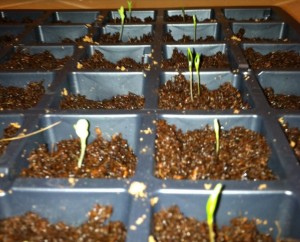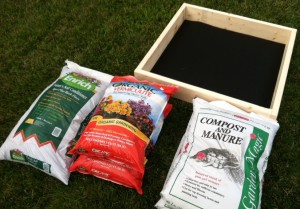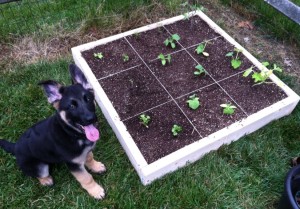This is the first year that my family and I are attempting to grow anything edible, I say that because I did try to plant a money tree once but it failed to yield anything of value. As someone who claims to be preparing for the worst, and especially someone who blogs about prepping you might be thinking that I have been slacking by not attempting to garden before this year…and you would be correct. In a previous post about square foot gardening I did very little to deny my shortcomings:
I’ll just come right out with it and admit that one of my weaknesses is growing food, or cultivating a sustainable food plan beyond what I have on shelves (read: non-renewable) in the basement. Ask me about fitness, tactics, prioritization, how to influence people, enduring freezing temps while wet and tired, tips for bartering…I’ll lay it out for you like it’s my job. Ask me to plant a garden in order to grow food which I can put on the dinner table and I’ll probably hang my head in shame.
On April 29th I posted a picture as we began our food growing journey. I’ll go ahead and re-post it here, this is what our garden started out as under a lamp in our kitchen.
We were shuttling the plants outside each day (they had been moved to larger containers) and sometimes bringing them in at night but that got to be ridiculous. So last week we decided to move the plants to their permanent home, a 3 x 3 raised bed garden which I built using shoddy craftsmanship at best. In addition to the box I purchased 3 items: Compost, Vermiculite and Pine Bark Fines. These would be mixed together in equal parts in the bed prior to the plants being given their new home. All of this was based loosely on material provided in the book Square Foot Gardening by Mel Bartholomew. Mel suggested Peat Moss for his mix but I couldn’t find it in a few of the stores I checked out, hence the Pine Bark Fines as a substitute.
With my box finished it was time to add the mix in equal parts and transfer the plants over. The box was filled halfway up and then watered to settle the mix, and then filled all the way up and watered again. We added some grid squares and planted based on what type of plant and how much space they would need to adequately grow (again information provided in the book). The list of plants which are in the box are as follows:
- Zucchini
- Tomato
- Carrot
- Pickle Cucumber
- Cucumber
- Lettuce
- Spinach
- Cauliflower
- Cilantro
*Additionally we have a few pots which we added mix to and planted hot peppers, sweet peppers and more tomato.
I hope you don’t mind the gratuitous dog pic next to the garden, he’s the GSD pup I’ve written about in the past. At 12 weeks old he is still crate training, but he learns very quickly and is generally very even tempered. That’s dirt on his tongue, he tries to eat everything including the soil in the box. If I tossed some roofing nails on the floor he would probably try to eat those as well, but I digress.
Anyways as far as the garden goes my expectations are low. I’m thinking there are three possible outcomes I should be prepared for:
1- Everything dies
2- Everything gets eaten by critters
3- Most things die and what is produced is inedible
Don’t get me wrong, my wife and I will be working very hard to maintain this garden in hopes that it will produce a glorious crop! I figure if I keep my expectations low I won’t be disappointed when things turn out ugly. Either way this is a new experience which has been very enjoyable, we have already been discussing new things to try out for next season. If you haven’t tried growing your own food try stepping outside of your comfort zone like we did and give it a shot, you’ll be pleasantly surprised how rewarding it can be.












8 comments
Skip to comment form
I would imagine that #2 on your list is the most likely thing you should be prepared for. As long as you keep the garden watered, everything should not die and most of what you produce will be edible as long as you pick it before it gets over ripe.
I have given away truck loads of zucchini and squash this year because the kids were getting tired of squash and zucchini and zucchini and squash on the rotation. They have had it stewed, stir fried, breaded and fried, creamed, and in casserole form since it started making. All that was after the freezer was full of it and we made zucchini and squash chips on the dehydrator.
I am about to let the okra go to the wayside. As usual, my wife planted two rows a 1/2 mile long (it seems like a 1/2 mile anyway) and I am getting tired of going out and cutting it so that it just keeps producing. It always amazes me how friends and family always show up wanting okra after I have chopped the stalks when I have been begging them for a month to come get all they want.
Author
I think I’m going to rig up a chicken wire “fence” around it, just to keep out the rabbits which I see scouting out my yard from afar. It sounds like your crops are thriving, maybe you should contribute some more gardening tips? 🙂
I’m assuming you can all of your food and save it for the winter?
A chicken wire fence would be an effective deterrent to the rabbits and it would be reasonably cheap as well. It might also keep your pup from digging things up. 🙂
My wife is the gardener in the family because I do not have the patience for it. I help her prepare the soil but she does all the planting and maintaining. I become the “harvest mule” when everything starts to make because she is usually busy freezing, canning, and dehydrating what we (she) have produced. She planted corn, okra, squash, peas, butter beans, zucchini, potatoes, watermelon, cantaloupe, tomatoes, and cucumbers this year. The garden was a little under 2 acres (not counting the peas) and we had 2 full acres of peas (white, purple hull, blackeye) and butterbeans. Way too much garden for our family of four and no way we could can or prepare everything that was produced, so we shared a lot with friends, family and neighbors.
We also started a small orchard this year. I set out four fig trees, ten peach trees, ten olive trees, and four pear trees to go along side of our fifteen established, pecan trees.
That is awesome Maj. Im pretty jealous. I am currently in the far off land where not even the locals can get something to grow. But as soon as I return you best believe there will be some planting.
PJ, make sure you have a good layer of tree clippings over those raised beds! i.e. paul gautschi in the back to eden garden film!
Author
Great tip, I’m hoping the pine tree fines accomplish the same thing. Stay safe over in the suck.
I started my first raised garden this spring, 4×8. I have tried to plant heirloom seeds and plants. So far the tomatoes have been a complete failure. They get big but no tomatoes, then they just up and die, within a day. My squash, zucchini and yellow, were pretty with plenty of blooms. I got a total of 4 yellow squash, then they just gave up and died. I have better luck with vegetable grown in containers. The cherry tomatoes are doing great. I have grown green onions, celery, and green beans.
Will spend some time building up the soil and try again.
olivia if your tomatoes grow a lot of leaves and vines but no tomatoes your probablt to high in nitrogen and low in potassium and or potash
as for squash i used to do great in pa but here in Fl i’ve struck out 3 times now i’m puzzled i think its bugs or disease but try different ways and fertilizers
wood ashes are good to boost the soil
I did one 4X8 and one 4X12 raised square foot gardens. The vermiculite, composted manure, etc. has NO nutrients in it. My first attempt at veges failed miserably. I replanted and got miracle gro granules and fertilized them profusely. They are not weed free as well because as you mow your grass,etc. the weeds will grow. They also really need an irrigation system unless you can remember to water them everyday. Hope this helps.